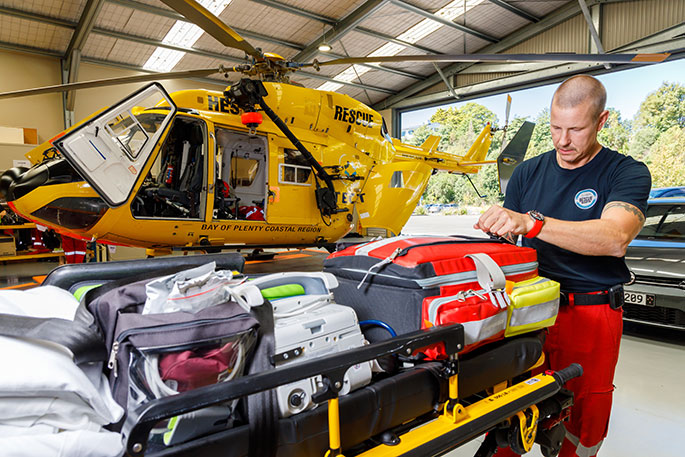Patients in distress are benefiting from swifter response times and critical care due to New Zealand's largest rescue helicopter operation leading the charge.
Philips Search and Rescue Trust has transformed itself into a fully-fledged air emergency medical service with the employment of its own full time Flight Paramedic work force, all experienced Intensive Care Paramedics.
PSRT enlisted their first paid Flight Intensive Care Paramedics in March 2019.
Now less than 12 months in, there are more than 20 air specific ICPs employed full time to service PSRT's coverage area. That being, Waikato Westpac Rescue Helicopter, TECT Rescue Helicopter, Greenlea Rescue Helicopter and the Palmerston North Rescue Helicopter.
In 2018, the National Ambulance Sector Office embarked on a systematic review of the provision of Air Ambulance Services for the whole of New Zealand.
They proposed a 10 year transformational plan, introducing initiatives to achieve consistent care delivery from road to air services, to improve patient outcomes in community emergency health, says a statement from PSRT.
'The impact of this investment and commitment to exceeding NASO standards is gradually being realised.
'The strict response time required under the NASO contract states rescue helicopters must be able to deploy within 10 minutes. The recruitment of Flight ICP's has transformed medical treatment and dramatically reduced prior response times, significantly raising patient care capability.”
Patient care, flight paramedic and team performance are reviewed regularly to ensure staff are supported and equipped to deliver their best to patients.
As part of the robust programme, all crew on board are also medically trained to assist the Flight ICP's.
'This required a complete reorientation of the service it provided,” says Muir Wallace, Medical Director for PSRT.
'No longer are we going to be responsible only for the aircraft and getting someone else's medical crew from base to an accident scene safely, we are now responsible for that medical crew too and all the clinical care provided to patients.”
The old system had served PSRT well, but the increasing workload of stretched road-based ambulance crews had meant their availability to crew helicopters was becoming increasingly scarce.
'This coupled with increased health and safety obligations, and more intensive and specific training requirements meant the only logical solution was to have employed full time Flight Paramedics who are qualified Intensive Care Paramedics.”
Previously, rescue helicopters were staffed by a pilot and crewman.
ICP's are highly skilled medical specialists qualified to assess, treat and manage the care of critical patients.
PSRT's full-time Flight ICP's come from many different backgrounds with many years of ambulance experience behind them both in New Zealand and internationally.
What followed this decision has been a year of recruitment and training, product testing and rollouts of different kits and pieces of equipment, says Muir.
'When we used road staff, they came in a fully stocked road ambulance and brought their kit and medicines with them. Now we too needed to provide a fully stocked ambulance, but one that could fly within its weight constraints.
'A lot of time and effort has gone into selecting light weight equipment to provide our Flight ICP's with the correct 'tools of the trade” appropriate for the environment in which we work.
'To be suitable for aeromedical use, equipment must be lightweight, tested, and approved to function under altitude and be strong enough to withstand the G forces within a helicopter environment sourcing these rare items come with a price tag.
'The recent crucial introduction of The Warrior Lite, a fluid and blood warmer, hails from Israel, it took a combined effort of all aeromedical regions, and a specialist medical equipment supplier to bring this into New Zealand to trial. Now it has passed these strict criteria, all aeromedical operators will eventually introduce them. The Warrior Lite weighs only 700g, yet costs $7000, and we need one per helicopter.”
Philips Search and Rescue Trust have worked hard over the last year to establish the service they are now providing across their four different rescue helicopter bases: Waikato Westpac Rescue Helicopter, TECT Rescue Helicopter, Greenlea Rescue Helicopter and the Palmerston North Rescue Helicopter, but it is not job done.
They still have several pieces of equipment to introduce and a large amount of work to bring the ongoing education and training to excellence level.
'The provision of prehospital medical care is ever-changing, and we need to change with it as treatments are adapted or new drugs introduced,” says Muir.
'It takes effort to stay on top of the game, but this is a challenge we are well set up for heading into 2020.”



1 comment
Great News
Posted on 04-03-2020 13:42 | By Yadick
This is long overdue but really glad and appreciative that it is rolling out. St John could do with striving toward excellence as well. They appear to be on a downward spiral. I work near the helicopter flight route over K Valley and most of the helicopters come cautiously and professionally in to the hospital but our big yellow one comes in like a bl@@dy idiot. Still, I'm really glad he's there. Just got to keep striving toward excellence Mr Pilot.
Leave a Comment
You must be logged in to make a comment.